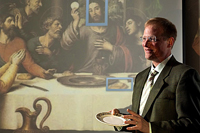 Last Supper helpings have grown
Last Supper helpings have grown
An unusual study looks at the food portions in artistic depictions of the Last Supper throughout history. The apostles have eaten better and better over the years, scholars say. Researchers found that from the years 1000 to 2000 the entrees depicted on the plates laid before Jesus' followers grew by about 70%, and the bread by 23%. (Jason Koski / Cornell University / Associated Press)
The Christian faith holds several acts of "super-sizing" to be miracles accomplished by Jesus Christ -- a handful of fish and loaves of bread expanded to feed thousands; a wedding feast running low on wine suddenly awash in the stuff. Now a new study of portion expansion puts Jesus once more at the center.
In a bid to uncover the roots of super-sized American fare, a pair of sibling scholars has turned to an unusual source: 52 artists' renderings of the New Testament's Last Supper.
Their findings, published online Tuesday in the International Journal of Obesity, indicate that serving sizes have been marching heavenward for 1,000 years.
"I think people assume that increased serving sizes, or 'portion distortion,' is a recent phenomenon," said Brian Wansink, director of the Cornell University Food and Brand Lab and author of "Mindless Eating: Why We Eat More Than We Think." "But this research indicates that it's a general trend for at least the last millennium."
To reach their conclusion, Wansink and his brother Craig, a biblical scholar at Virginia Wesleyan College, analyzed 52 depictions of the meal the Wansinks call "history's most famous dinner party" painted between the year 1000 and the year 2000.
Using the size of the diners' heads as a basis for comparison, the Wansinks used computers to compare the sizes of the plates in front of the apostles, the food servings on those plates and the bread on the table. Assuming that heads did not increase in size during the second millennium after the birth of Christ, the researchers used this method to gauge how much serving sizes increased.
And increase they did.
Over the course of the millennium, the Wansinks found that the entrees depicted on the plates laid before Jesus' followers grew by about 70%, and the bread by 23%.
As entree portions rose, so too did the size of the plates -- by 65.6%.
The apostles depicted during the Middle Ages appear to be the ascetics they are said to have been. But by 1498, when Leonardo da Vinci completed his masterpiece, the party was more lavishly fed. Almost a century later, the Mannerist painter Jacobo Tintoretto piled the food on the apostles' plates still higher.
New York University nutrition researcher Lisa R. Young called the Wansink study fun. But as the author of "The Portion Teller," a history of portion size through the 20th century, she also pointed to the three decades that ended the millennium as a "tipping point" for humankind.
There is scant evidence that the body mass index of people in developed societies soared into unhealthy ranges for most of the 1,000 years studied, Young said. But there is little doubt, she added, that that changed in the 1970s, 1980s and 1990s -- coincidentally, when portion sizes began a dramatic run-up.
The Wansinks, however, suggest that portion growth may have a provenance far older than industrial farming and the economics of takeout food.
Instead, they suggest, it's a natural consequence of "dramatic socio-historic increases in the production, availability, safety, abundance and affordability of food" over the millennium that started in the year 1000 A.D.
"The contemporary discovery of increasing food portions and availability may be little more than 1,000-year-old wine in a new bottle," the Wansinks wrote.
melissa.healy@latimes.com
 Last Supper helpings have grown
Last Supper helpings have grown